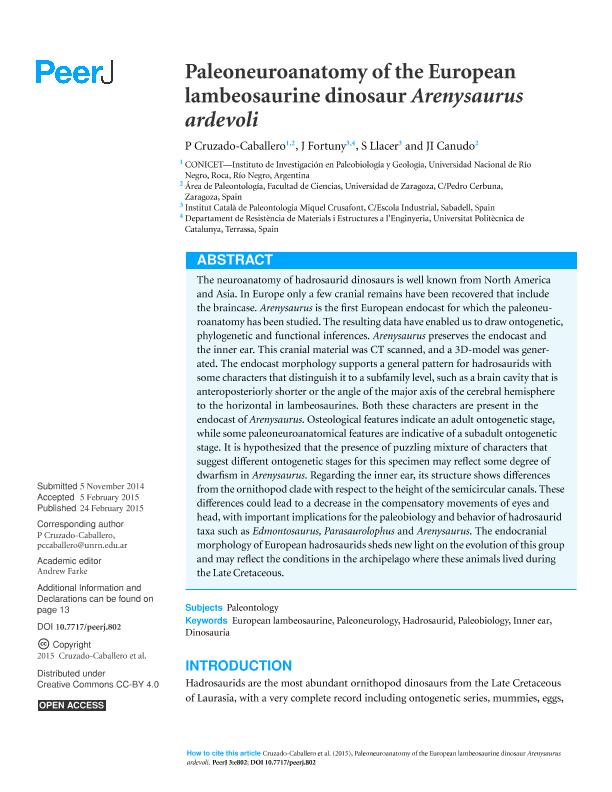Artículo
Paleoneuroanatomy of the European lambeosaurine dinosaur Arenysaurus ardevoli
Fecha de publicación:
24/02/2015
Editorial:
PeerJ, Inc
Revista:
PeerJ
ISSN:
2167-8359
Idioma:
Inglés
Tipo de recurso:
Artículo publicado
Clasificación temática:
Resumen
The neuroanatomy of hadrosaurid dinosaurs is well known from North America
and Asia. In Europe only a few cranial remains have been recovered that include
the braincase. Arenysaurus is the first European endocast for which the paleoneuroanatomy has been studied. The resulting data have enabled us to draw ontogenetic, phylogenetic and functional inferences. Arenysaurus preserves the endocast and the inner ear. This cranial material was CT scanned, and a 3D-model was generated. The endocast morphology supports a general pattern for hadrosaurids with some characters that distinguish it to a subfamily level, such as a brain cavity that is anteroposteriorly shorter or the angle of the major axis of the cerebral hemisphere to the horizontal in lambeosaurines. Both these characters are present in the endocast of Arenysaurus. Osteological features indicate an adult ontogenetic stage, while some paleoneuroanatomical features are indicative of a subadult ontogenetic stage. It is hypothesized that the presence of puzzling mixture of characters that suggest different ontogenetic stages for this specimen may reflect some degree of dwarfism in Arenysaurus. Regarding the inner ear, its structure shows differences fromthe ornithopod clade with respect to the height of the semicircular canals. These differences could lead to a decrease in the compensatory movements of eyes and head, with important implications for the paleobiology and behavior of hadrosaurid taxa such as Edmontosaurus, Parasaurolophus and Arenysaurus. The endocranial morphology of European hadrosaurids sheds new light on the evolution of this group and may reflect the conditions in the archipelago where these animals lived during the Late Cretaceous.
Palabras clave:
Paleoneurology
,
Paleobiology
,
Inner Ear
,
European Lambeosaurine
,
Dinosauria
Archivos asociados
Licencia
Identificadores
Colecciones
Articulos(CCT - PATAGONIA NORTE)
Articulos de CTRO.CIENTIFICO TECNOL.CONICET - PATAGONIA NORTE
Articulos de CTRO.CIENTIFICO TECNOL.CONICET - PATAGONIA NORTE
Articulos(SEDE CENTRAL)
Articulos de SEDE CENTRAL
Articulos de SEDE CENTRAL
Citación
Cruzado Caballero, Penélope; Fortuny, J.; Llácer, S.; Canudo, J. I.; Paleoneuroanatomy of the European lambeosaurine dinosaur Arenysaurus ardevoli; PeerJ, Inc; PeerJ; 3; 802; 24-2-2015; 1-16
Compartir
Altmétricas




